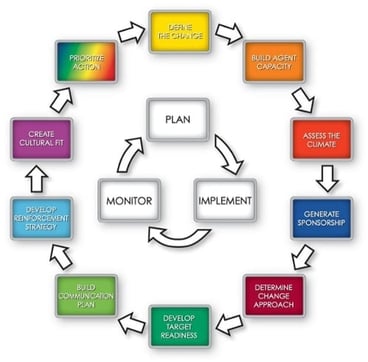We often get questions about the Accelerating Implementation Methodology (AIM) change management methodology from people who are already certified in Prosci’s ADKAR model. That makes sense. Both methodologies are sound change management frameworks that share a lot of common elements. 
In fact, on the surface both AIM and the ADKAR model address similar aspects of the people side of change. But over the years we’ve spoken to a lot of people who are certified in both methodologies. They tell us when you dig a little deeper, there are several fundamental differences between the two frameworks. If you are in the market for a new change management methodology and are comparing AIM and the ADKAR model, here are a few of the differences to consider:
Structure
ADKAR Model: The ADKAR model is a "linear approach" that provides users with a map for implementing a change by completing a prescribed set of tools and templates.
AIM: AIM is based on the idea that change is dynamic and cyclical, not linear. It is designed to be flexible, scalable, and principle-based. This means users learn the principles, and then call on those principles to know what to do given what is occurring at any given moment during an implementation. The over-arching goal is to determine how to get maximum impact from people in the shortest amount of time possible, and to get full benefit realization for strategic change investments.
Tools and Templates
ADKAR Model: Prosci’s methodology is tool and template driven and offers a wide number of checklists and templates, some of which are automated.
AIM: AIM also includes tools and templates, but they are focused around a set of robust measurement diagnostics that work together with the principles of the methodology to provide "directional guidance" on where to best apply your finite resources. 
Core Elements
ADKAR Model: The ADKAR Model’s Roadmap addresses 5 core elements of the people side of change: Awareness, Desire, Knowledge, Ability and Reinforcement.
AIM: AIM addresses the same elements, but they are achieved by applying the principles, strategies, and tactics in a fit for purpose manner. AIM’s core elements include: Defining the Change, Generating Sponsorship, Creating Target Readiness, Building a Communication Plan and Developing a Reinforcement Strategy.
Defining the Change
ADKAR Model: The ADKAR model includes an Impact Analysis as part of its toolkit. However, our clients who are certified in the ADKAR model tell us this tool does not in itself trigger a detailed definition of the change.
AIM: Defining the Change is the starting point of every change initiative. The output of Defining the Change is a Business Case for Action that describes what is changing, why it is changing, what the consequences are for not changing, and identification of the behaviors sought in the future state. If you don’t define the behaviors you seek to see, you can’t reinforce and measure them.
Sponsorship
ADKAR Model: Prosci’s ADKAR model works to create a critical mass by training and coaching people on the ground on how to assist with implementing the change. Leaders are responsible for three actions:
1) Participate actively and visibly
2) Build a coalition of managers and peers
3) Communicate effectively with employees
AIM: The AIM methodology defines Sponsorship as both action and organizational position. Anyone who has direct reports impacted by the change is a Sponsor, and must demonstrate the following three actions:
1) Express commitment to the change by what they say publicly and privately
2) Model commitment by the resources they allocate and the decisions they make
3) Reinforce new behaviors by applying rewards and consequences on a day-to-day basis, and making adoption of the new way easier
Of the three actions, Reinforcement is the most powerful. This “cascade” of demonstrated commitment from every Sponsor, level by level in the organization is what drives fast and successful change.
Reinforcement
ADKAR Model: One of our clients who is certified in the Prosci methodology says, “The reinforcement strategy of the Prosci methodology lacks the emphasis on behavioral change – it is more aimed at compliance – checking if people are doing the new things they should.”
AIM: In AIM, the Reinforcement that takes place between each manager and his/her direct report is the “power lever” for ensuring swift and sustained adoption of change. These include positive rewards, negative consequences, and making it easy for individuals to adopt the new way vs. continue with the old way.
Which Change Process is Right for Your Organization?
When you shop for a change methodology it is important to compare methodologies and then make a decision based on what your organization needs.
If you are looking for a set of checklists and templates that can be integrated into your projects, then the Prosci methodology and the ADKAR model may work well. But if you have a more complex organization where changes are happening across multiple functional business units and where you are dealing with multiple Sponsors (i.e. enterprise-wide and/or transformational changes) you will find the inherent scalability of AIM extremely useful.
Change management is about getting the maximum impact from your limited resources in the shortest amount of time {Tweet This}. After 35+ years focused entirely on implementing large-scale and complex changes worldwide, we are firm believers that impact is far more important than activity. So when it comes to the hard work of implementation, you have a choice. In the end, which change management methodology are you going to choose?


